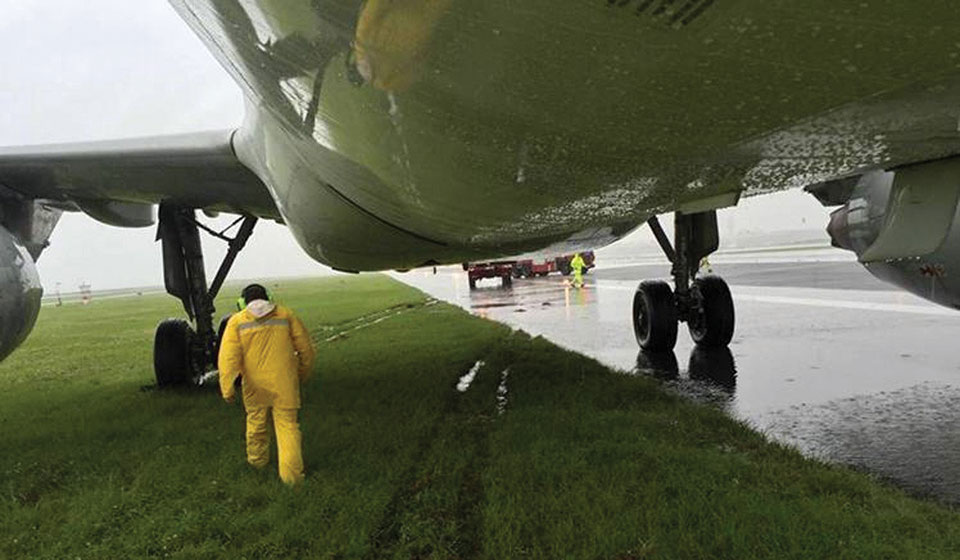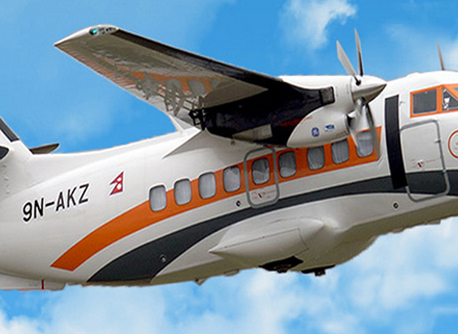
OR

Not being able to find proofs of something that had definitely happened is quite frustrating. I had encountered the same as mentioned in my previous piece. This time I was looking for details of a helicopter accident on TIA runway that had resulted in several hours of airport closure.
Obviously, the accident was the first-page news item the next day, with an image of the chopper lying helplessly on its side. There were no fatalities as it happened quite close to the ground. The good news is I have finally managed to trace both the elusive links. The copter was Army’s Mi-17 (RAN-36) which was severely damaged during take-off on September 23, 2002 as the result of tail rotor failure. It was subsequently sent for repairs to a plant in Engels, in Russia, minus the tail boom. The repair and overhaul seem to have been completed finally in December, 2008, but it is not clear if it has since returned. As such, the topic this time revolves around runway closures more due to runway excursions than incursions as TIA is seen suffering from such happenings quite frequently.
Excursions and incursions
People often get confused with uncommon terms like “incursion” and “excursion”. The former is described as incorrect/unauthorized entry/presence/crossing by an aircraft or vehicle or personnel in passage demarcated for exclusive aircraft use. As such, areas like taxiways should not be transgressed without permission. For example, even if an aircraft misses to exit/enter the runway as instructed by ATC, it is taken as an incursion. It can have serious repercussions complicating movements of both ground and air traffic. Most of incursion related accidents tend to be minor bump by utility vehicle or luggage trolley or worse like one aircraft brushing against another. Squeezing more aircrafts in an area suitable for far too less is a sure spot for frequent such happenings. No other airport can possibly beat TIA’s record for jam-packing 30 or more aircrafts in a space designated for just 17 as per Civil Aviation Expert Narayan Dangol.
A runway “excursion”, on the other hand, occurs when an aircraft somehow “departs” or gets on to the peripheral area beyond the runway surface, during take-offs/landings. This can either be intentional or otherwise. It generally happens when a departing aircraft fails (a) to get airborne or intentionally rejects the take off before reaching the end of the runway (b) a landing aircraft is unable to stop before the end of the runway is reached and (c) the third involves aircraft veering off, partially or fully, to either side of the runway during rejected take-off or while landing. If the verge happens to be soft it can lead to sinking or even breaking of undercarriage compounding retrieval difficulties. That is not all. Retrieval becomes even more pressing when the airport itself gets shut due to safety concerns. Moving away may take just a few hours or even few days depending on how difficult it is. Airports like TIA, with single runway, are forced to bear total standstill while those with more than one runway can operate but at reduced capacity.
Intentional excursions are more due to safety concerns during take-offs. The aircraft can either stop successfully within the runway area or overrun the length while trying to stop. An ideal rejected take-off is one in which the aircraft exits the active runway on its own power or hauled out quickly. Or worst, it might stand disabled on the runway with busted tires due to severe braking. Again, this may take several hours depending on how many tires need to be changed. Few years back a Chinese airline B757 had busted six of its 10 tires at TIA under similar circumstances. As it was not a Bhatbhateni thing that one can just buy off the shelf, securing as many tires was a big issue until, of course, RA threw the lifeline by loaning out tires from its stock.
Cases at TIA
TIA has numerous incidents/accidents matching to each of the incursion/excursion scenarios mentioned above. The record of first jet related runway overshoot goes to TG311/DC8 of Thai International as it attempted to land from RWY20 (May 1973).The first wide-body one relates to Turkish Airways flight TK726/A330 (March 2015) that resulted in TIA being immobilized for full four days. Surely, it would not have taken as long if similar accident had happened elsewhere. It is understandable that it takes time to clear wide bodies because of complication involved. Stuck as a stubborn bull the A330 became safety hazard because of runway proximity. Necessary “lifting airbag” kits for events like this took time to arrive as these are spread globally to be shared by countries nearby. But major predicament was brought upon by the lack of even basic equipments required for moving away a wide body.
Not long ago it was Malindo/B737 (April, 2018) that ran aground some 50 meters beyond RWY-02. Given the dearth of appropriate tools and required logistic items its clearing took more than 12 hours against anticipated four. It might as well have been the lack of steel cable as per a joke that floated around then. That aside, it took 11 hours to remove a domestic aircraft that suffered a similar runway excursion in September last year, few months after Malindo. Even Twin Otters are seen to take no less than two to three hours to move away with nothing serious than a tire bust. It is understandable that we cannot be as efficient in moving away a stricken wide-body but we should have, at the very least, enough kits/logistics in store to move the smaller ones quickly without much ado. Such incidents will continue to happen in spite of best of aircraft maintenance practices. We have to be prepared by increasing our capabilities before such events crop up unexpectedly. Elsewhere, the airport emergency team maintains contact details of local crane companies with enough tools to do the job quickly. We possibly do not have such type of agents as yet.
Interestingly, in a recent case an ATR72-500 (9N-AMM) of one domestic airline had a runway excursion incident following landing during heavy rain that led to airport closure that seriously affected flights of all others, including international carriers. India had four excursion cases in 72 hours recently, all related to rain and wet runways. Instances of runway excursions more likely happen during monsoon. As such, Indian safety experts have voiced concerns that its carriers need to review standard operating procedures known to help facilitate safe approaches and landings. The issue aroused so much concern that the Civil Aviation authority there had to issue an air safety circular urging precautions and a need for pilots to refrain from making unstabilized approach. Hoping to drive the point harder, the Indian authority went on to the extent of suspending the licenses of two pilots for one year for overshooting the main runway at Mumbai airport. It took 90 long hours of nonstop effort to move the aircraft away last month. A logical way out would have been to divert or be on hold till the situation got better. Attempt to land with “come what may” attitude gives out the unpleasant whiff of complacent behavior, if nothing better.
And here, the attitude of ATR’s pilot showed it was no different. It was more so as another aircraft of the same company, ahead by a few minutes, saw it wiser to divert than land. Seen from another angle, it became public only because of the jinxed end. No one would have known otherwise. It is assumed that the longing for the feel of tire rolling on the secure tarmac becomes desirable at the end of each flight. But it would still be logical and safe to divert than be singled out for inflicting unwarranted consequences of one’s poor judgment on others. It was, undoubtedly, a sad case of over confidence in a grossly unfavorable situation. Hope that our pilots have the courage to reflect calmly and take the right decision at such critical junctures.
harjyal@yahoo.com
You May Like This

Taking for granted
One runs out of topic even when writing about the unending plight of an airport or an airline. At times... Read More...

Tara Air meets with accident while landing at Jumla Airport, all on-board safe
JUMLA, Jun 9: A Tara Air with Call Sign 9N-AEV has met with an accident while landing at the Jumla Airport... Read More...

Goma Air aircraft’s tire flattens while landing at Talcha Airport
MUGU, Jan 11: An aircraft of Goma Air that had flown from Nepalgunj with 15 passengers on board averted an... Read More...







Just In
- NRB to provide collateral-free loans to foreign employment seekers
- NEB to publish Grade 12 results next week
- Body handover begins; Relatives remain dissatisfied with insurance, compensation amount
- NC defers its plan to join Koshi govt
- NRB to review microfinance loan interest rate
- 134 dead in floods and landslides since onset of monsoon this year
- Mahakali Irrigation Project sees only 22 percent physical progress in 18 years
- Singapore now holds world's most powerful passport; Nepal stays at 98th












Leave A Comment